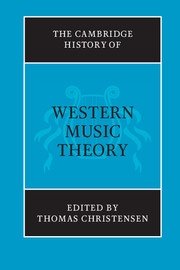Book contents
- Frontmatter
- Introduction
- PART I DISCIPLINING MUSIC THEORY
- PART II SPECULATIVE TRADITIONS
- PART III REGULATIVE TRADITIONS
- A Mapping tonal spaces
- B Compositional Theory
- C Time
- D Tonality
- 23 Tonality
- 24 Rameau and eighteenth-century harmonic theory
- 25 Nineteenth-century harmonic theory: the Austro-German legacy
- 26 Heinrich Schenker
- PART IV DESCRIPTIVE TRADITIONS
- Index of authors
- Index of subjects
- References
24 - Rameau and eighteenth-century harmonic theory
from D - Tonality
Published online by Cambridge University Press: 28 March 2008
- Frontmatter
- Introduction
- PART I DISCIPLINING MUSIC THEORY
- PART II SPECULATIVE TRADITIONS
- PART III REGULATIVE TRADITIONS
- A Mapping tonal spaces
- B Compositional Theory
- C Time
- D Tonality
- 23 Tonality
- 24 Rameau and eighteenth-century harmonic theory
- 25 Nineteenth-century harmonic theory: the Austro-German legacy
- 26 Heinrich Schenker
- PART IV DESCRIPTIVE TRADITIONS
- Index of authors
- Index of subjects
- References
Summary
The more complex a natural entity is, and the more interrelated its components are, the harder it often is for us to comprehend how it could have evolved from completely independent constituent elements. Human vision, for instance, is so immensely complex, with numerous specialized parts both in the eye itself and in the way that the brain processes visual signals, that it is difficult to imagine how each component evolved both separately and in interaction with its affiliates before the final, highly integrated developmental stage existed. The same is true of complex cultural systems that have evolved over long periods of time, among which is harmonic tonality. Virtually every aspect of harmonic tonality (tertian harmonies as primary compositional structures, contrapuntal voice leading connecting those harmonies, the bass as a harmonic foundation, notions of root generation, harmonic motion directed toward cadential goals, the interaction of diatonic scales and chromaticism, and the interaction of harmony and counterpoint with rhythm and meter) arose before tonal harmonic syntax existed. Even though those components interact quite intricately in tonal music, each arose within different musical contexts, and each was explained autonomously by teachings having long, independent theoretical traditions.
The individual who first recognized that all those components interacted to create a sense of tonality was the French theorist and composer Jean-Philippe Rameau (1683–1764). Although Rameau proposed some original ideas, a major part of his theorizing in the treatises he published between 1722 and 1761 consisted of reformulating and combining long-standing concepts into a single harmonic, directional perspective. Rameau is an instance of that relatively rare theorist who was a major composer as well. Because of this, as much as he pursued theoretical ideas for their own consistency, he generally remembered that the function of a theory of harmony was to explain music as he understood it compositionally. This chapter traces many of these concepts and their attendant pedagogical traditions as inherited by the early eighteenth century, and then considers Rameau’s brilliant accomplishment of consolidating them into a unified (if not completely stabilized) harmonic theory. Lastly, this chapter surveys the evolving legacy of this now-dominant heritage in the late eighteenth century and beyond.
- Type
- Chapter
- Information
- The Cambridge History of Western Music Theory , pp. 753 - 777Publisher: Cambridge University PressPrint publication year: 2002
References
- 46
- Cited by



